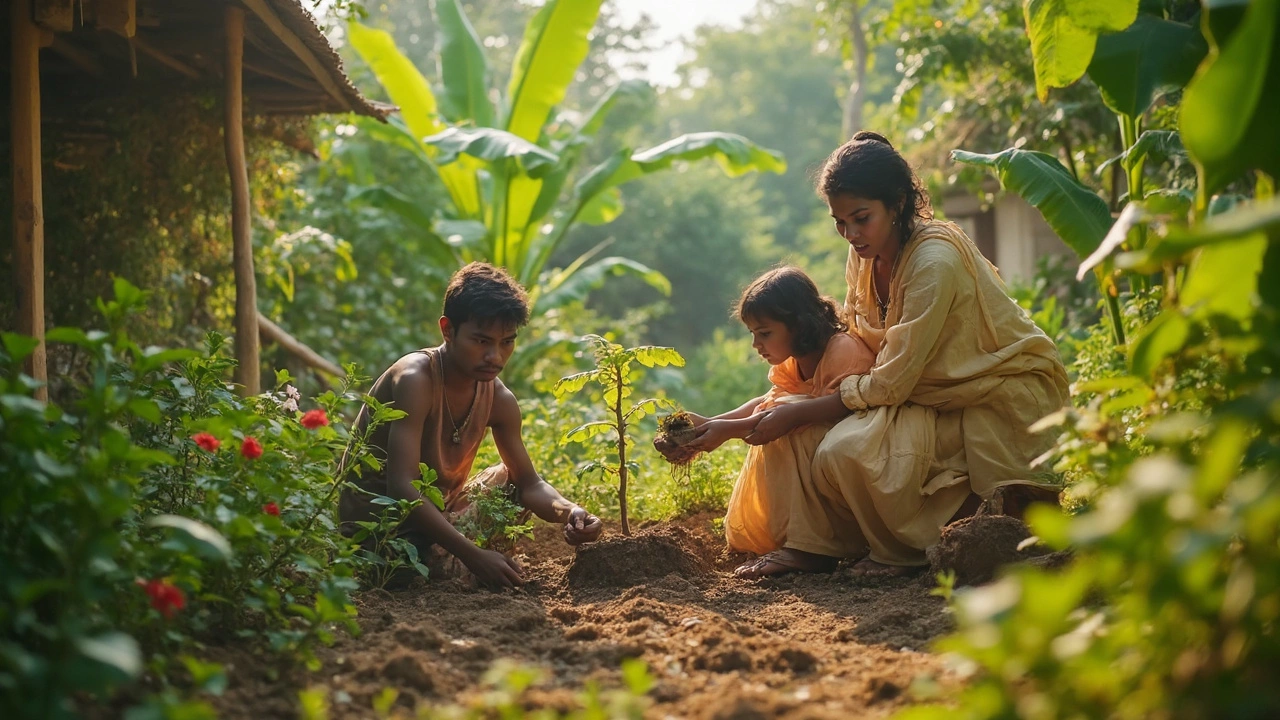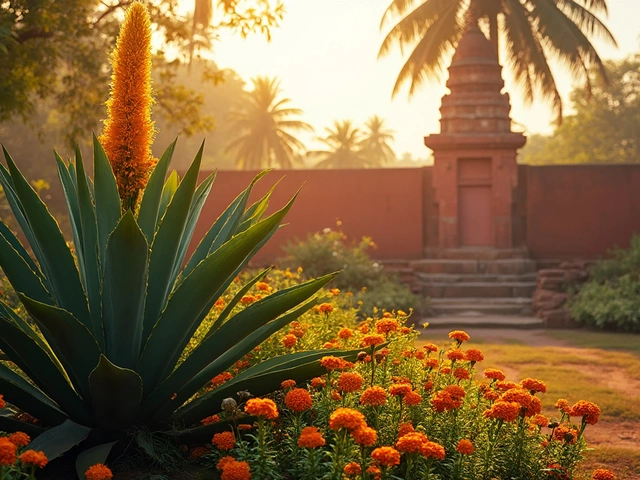Most yards look neat but don’t offer much life. That’s a missed chance. When you make an ecosystem garden, you’re building a living system where plants, bugs, and birds all have a role—and the garden pretty much cares for itself.
You don’t need a big yard or expensive gear to get started. The trick is to stop thinking of your garden just as a spot for flowers or veggies and start thinking of it like a little patch of wild. Native plants draw butterflies and bees, healthy soil snacks up kitchen scraps, and a birdbath can attract dozens of different bird species in just one summer.
What surprises a lot of people: If you set things up right, an ecosystem garden needs less water, less mowing, and almost no chemicals. Even in a suburban neighborhood, you can grow food, see frogs and fireflies, and actually lower your workload each year.
- Understanding Ecosystem Gardening
- Planning Your Space for Balance
- Choosing the Right Plants
- Water, Soil, and Natural Cycles
- Inviting Wildlife and Managing Pests
- Maintenance: Keeping It Simple
Understanding Ecosystem Gardening
An ecosystem garden is way more than a pretty space—it's a living, breathing system that copies what you’d find in nature. Instead of single rows of flowers or just a patch of grass, you’ve got layers: trees, shrubs, ground plants, and all the stuff going on below the soil. Every living thing is connected. That's what keeps a forest or meadow healthy without someone watering or mowing all the time.
Why go for this approach? For one, you boost biodiversity and let nature do most of the work. A balanced ecosystem garden brings in helpful bugs like bees and ladybugs, which pollinate and control pests. Birds find food and places to nest. Even earthworms get in on things by breaking down scraps and pumping air through the soil.
- Native plants are the backbone here. They're the ones that already handle your local weather and soil, so you water less and skip sprays.
- Wildlife, from frogs to butterflies, finds safe spots to hang out and breed.
- Soil stays healthy since leaves and prunings break down right in place, skipping the landfill.
Some people worry these gardens look "wild" or messy. But there's actually a pattern. The trick is to copy nature’s setup with layers—think tall at the back, short at the front, and give everything a job. Here’s a simple breakdown of all the working parts and their jobs:
| Layer/Part | Role in the Garden |
|---|---|
| Trees/Shrubs | Shade, structure, shelter for wildlife |
| Flowering Plants | Nectar and pollen for bees & butterflies |
| Groundcovers | Keep weeds down, stop soil erosion |
| Dead Wood/Leaves | Habitat for insects, natural mulch |
When you let these parts work together, your ecosystem garden gets stronger every year. Less work for you, more life all around. That’s the goal.
Planning Your Space for Balance
Before grabbing a shovel, step back and check out your yard in detail. Sun, shade, slopes, soggy patches—every backyard is different. In a ecosystem garden, you want to match what’s already there instead of fighting it. Watch how much sun different spots get and note which parts stay wet after rain. This groundwork saves you time and effort later.
Sketching your space helps. It’s not about artistic skill—just mark out trees, fences, the house, and any hardscapes. Circle spots that get full sun (over 6 hours), partial shade, or complete shade. You’ll match plants to these zones so they thrive with minimal fuss.
- Mark natural pathways where people or pets walk—avoid planting delicate stuff here.
- Leave space for small water features or woodpiles, which attract helpful critters.
- Add several layers: tall trees for shade, shrubs, smaller flowering plants, and groundcovers. Layers bring more biodiversity and make the space feel wild and full.
Don’t forget about kids. My son Rohan loves to help, so we picked spots for stepping stones and a patch just for digging. Even a small corner can become a “wild” play zone if you plan ahead.
If you think your yard is too tiny—think again. Data from urban gardens shows a mix of native plants in even postage-stamp lots can boost pollinator visits by over 50% compared to traditional lawns:
| Garden Type | Pollinator Visits per Week |
|---|---|
| Lawn (simple grass) | 3-5 |
| Ecosystem Garden (mixed native plants) | 15-40 |
Think about how you spend time out there, too. If you do backyard cookouts, leave space for a grill or picnic table. Setting up smart means your backyard habitat works for you and the local wildlife, all at once.
Choosing the Right Plants
Picking plants for your ecosystem garden isn’t about grabbing whatever looks good at the store. The best trick is to go for native plants—that means ones that grew naturally in your area long before lawns were a thing. These plants already know how to handle the local weather, bugs, and soil. They use less water, don’t beg for fertilizer, and survive weird weather swings.
Here’s why natives rock: they support local bees, butterflies, and birds. Monarch caterpillars, for example, only munch on milkweed. No milkweed, no monarchs. Same goes for other critters—take away their food, and they skip your yard.
- Check your state or region’s native plant list. Most garden centers can help, or you can find lists online from local botanical gardens or university extensions.
- Mix it up—shrubs, wildflowers, grasses, and trees all bring something different to the table. Pollinators love flowers like purple coneflower, goldenrod, or bee balm. Birds might go for berry bushes like serviceberry or elderberry.
- If you want an edible twist, try native fruit plants or herbs—things like blueberries, pawpaw trees, or wild strawberries.
Skip the popular imported stuff (like Japanese barberry or English ivy). A lot of these actually crowd out our helpful native plants, mess up soil, and offer nothing for local wildlife. Some are even banned in certain places.
Picking a mix of plants that bloom and fruit at different times keeps your garden lively from spring through fall. Here’s a handy cheat sheet for a Northeast US garden:
| Type | Native Example | What It Attracts |
|---|---|---|
| Wildflower | Milkweed | Monarch butterflies |
| Shrub | Serviceberry | Birds, bees |
| Grass | Little Bluestem | Insects, birds |
| Tree | Redbud | Pollinators, birds |
Still not sure where to start? Try planting just one area with natives and let them spread. Watch how much more action you get from both critters and neighbors.

Water, Soil, and Natural Cycles
A real ecosystem garden works because water, soil, and life all connect—just like in the wild. Forget constant watering or fancy fertilizers. Nature already has a better plan.
Let’s start with water. Most people overwater, but native plants actually prefer drier spells once they’re settled in. Add rain barrels to collect water off your roof. Water early in the morning, close to the soil, so it soaks in instead of evaporating. Put mulch (chopped leaves, wood chips, or even straw) around your plants. That locks in moisture, fights weeds, and feeds your soil as it breaks down.
Healthy soil is the backbone of any sustainable gardening idea. Don’t rip it up every spring. Just top-dress with compost and let the worms do the work. Test your soil once—basic kits cost about the same as takeout pizza. If your dirt’s sandy, add organic matter. Heavy clay? Add compost and rake it in gently. Mulch helps even out extremes, keeping roots happy all year.
Now for cycles—the secret weapon. Every patch of green breaks down, feeding a new round of life. Compost kitchen scraps and yard waste in a corner pile. Skip chemical sprays and let beneficial bugs handle most pests. They show up as long as you put out the welcome mat (like dense shrubs, logs, and a small water dish). When birds eat caterpillars and ladybugs gobble aphids, that’s your ecosystem garden running smoothly without your help.
| What To Add | Why It Helps |
|---|---|
| Mulch (2–3” deep) | Locks in moisture, feeds soil microbes |
| Compost | Adds nutrients, improves texture |
| Native plants | Use less water, support pollinators and birds |
| Rain barrels | Saves tap water, reduces runoff |
All these steps keep your backyard habitat healthy with less outside input. With time, you’ll spot worms, bees, and robins doing the hard work for you. That’s the real win—your space gets wilder and easier every year.
Inviting Wildlife and Managing Pests
This is where your ecosystem garden gets interesting. A healthy garden isn’t silent—it’s full of animal life. You want bees, butterflies, birds, frogs, even the occasional toad or garter snake. Why? Because every critter, big or small, helps balance things out. For example, birds eat caterpillars and beetles, and frogs snap up mosquitoes. That means less work fighting pests.
Start simple. Fresh water brings in wildlife fast. Put out a birdbath or shallow bowl and keep it filled. If you add a rock for bees and butterflies to land on, you’ll start spotting visitors in days. Choose native plants that flower at different points in the year—this helps feed everything from early bumblebees to late-season hummingbirds. A patch of leaf litter or a pile of twigs in the corner gives ladybugs and ground beetles somewhere to hide.
It sounds weird, but letting some things go a bit wild actually keeps your garden healthier. When my son Rohan left a log in the garden, we found salamanders under it a month later. They eat slugs. Win-win.
If you spot a pest problem, resist the urge to spray chemicals. Nine times out of ten, the solution is more diversity, not less. Here are some straightforward ways to keep pests under control naturally:
- Plant a variety of native plants. This attracts critters that eat pests and keeps no one bug from taking over.
- Grow herbs like dill, mint, or fennel near veggies—these attract beneficial bugs that snack on aphids and mites.
- Mulch with leaves or wood chips. This keeps soil moist and helps beetles and centipedes hide; both are major pest-eaters.
- If you spot a bunch of bugs, check if they’re a problem before acting. Often, the pest will disappear in a week when something eats it.
Keen on numbers? A recent survey found that yards with more bird species had up to 70% fewer caterpillar outbreaks than lawns with little bird activity.
| Wildlife Visitor | What They Eat | Garden Benefit |
|---|---|---|
| Chickadees | Caterpillars, beetles | Natural pest control |
| Ladybugs | Aphids, mites | Protect plant leaves |
| Frogs | Mosquitoes, slugs | Less biting bugs |
| Butterflies | Flower nectar | Boost pollination |
If you do need to step in, try hand-picking pests or spraying soapy water on affected plants. Leave space for nature to handle the rest. The goal? Partner with your garden, not fight against it.
Maintenance: Keeping It Simple
Once your ecosystem garden is up and running, you’ll notice the workload is nothing like a standard yard. Forget mowing every week or chasing after weeds all summer. An ecosystem garden is designed to balance itself—but there are a few things to keep on your radar.
Start by checking the basics every month or so. Walk through your garden and just see what’s buzzing, blooming, or maybe not thriving. Early signs of an issue, like wilting native plants or lots of aphids, are easier to fix right away.
- Mulching: Mulch does half the work for you. It keeps the soil moist, blocks new weeds from popping up, and even gives worms some snacks. Every spring, scatter a fresh layer of organic mulch—like wood chips or leaf litter—under your plants.
- Watering: If you picked mostly native plants, you’ll barely need to water after the first year. But during really dry spells, aim for a deep soak at the base of plants. No need to break out the sprinkler every week.
- Pruning: Just a light trim now and then is enough. Remove dead branches or spent flower heads in late winter so new growth gets a head start. Let seed heads stick around if you want to feed birds through the cold months.
- Composting: Toss grass clippings, raked leaves, and kitchen scraps onto a compost pile or in a tucked-away corner. It turns into rich soil with almost no effort. Don’t bother turning it daily; just let nature take the lead.
- Monitoring wildlife: If you spot lots of certain pests (like Japanese beetles) or fewer pollinators, jot a note. Sometimes, adding a small log pile or water dish brings in helpful bugs and birds to re-balance things.
If you’re curious how much time you’ll save, there was an outdoor lifestyles survey last year: folks with sustainable gardening setups like these reported spending about 30% less time each week on yard work compared to a traditional lawn. Plus, most saw more wildlife after just one season. The key is to check things often—but only do what’s really needed. Nature handles the rest.





